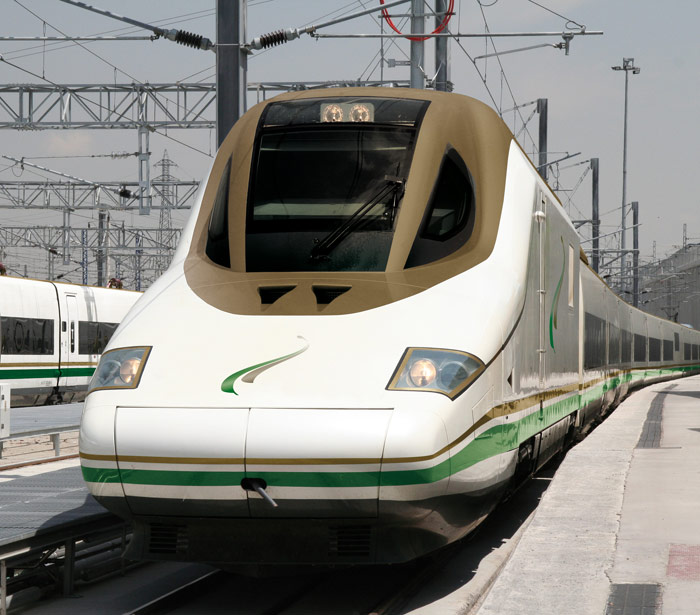High-Speed Rail Mega Contract
The Spanish consortium led by Talgo, Renfe, Adif and OHL has been awarded the Very High-Speed Rail Saudi Arabia mega-contract
• This award consolidates Talgo’s worldwide position in the very high-speed rail market.
 Madrid, October 26, 2011 - A Spanish consortium of eleven companies has been awarded a $9 billion turn-key very high-speed rail project to connect the Saudi Arabian Cities of Medina and Mecca. Talgo’s role in the project entails the design, manufacture and maintenance of the trainsets for a value of $2.4 billion, which may increase to $3.4 billion if the option for additional trainsets options is executed.
Madrid, October 26, 2011 - A Spanish consortium of eleven companies has been awarded a $9 billion turn-key very high-speed rail project to connect the Saudi Arabian Cities of Medina and Mecca. Talgo’s role in the project entails the design, manufacture and maintenance of the trainsets for a value of $2.4 billion, which may increase to $3.4 billion if the option for additional trainsets options is executed.
The project relies on Talgo’s rolling stock technology and consolidates the company’s position in the very high-speed rail market. The Saudi Arabian authorities have taken in consideration the success of the high-speed rail model in Spain. Such award confirms that Talgo is not only a company with a successful line of products that are sold very well in its domestic market, but also that its state-of-the-art designs are internationally acclaimed. Talgo’s expansion in the international market started in 1992 with sales in Germany, followed by sales in the USA in 1994. From 2007 to 2010 Talgo was also awarded major contracts in Kazakhstan, Uzbekistan, USA and Russia. These latest developments have consolidated Talgo’s commitment to be a worldwide rail manufacturer. In 2010, 83% of the new contracts awarded to Talgo came from customers located outside of Spain.
According to Chairman Carlos de Palacio, “The award of this major contract is a milestone for the Spanish rail industry and rail technology and allows Talgo to fulfill its internationalization strategy. Further, this award adds competitiveness to bid in international high-speed rail projects”. Currently Talgo is working to develop business in 25 different countries.
Trainset offered
The trainset offered is the very-high-speed Talgo 350 (known in Spanish as “El Pato” for its duck head shape). It is the latest high-speed train sold in Spain, which enjoys 50% of the market share in this segment connecting the city pairs of Madrid-Málaga, Madrid-Valencia, Madrid-Valladolid, Barcelona-Málaga and Barcelona-Sevilla.
The Spanish consortium has been awarded 35 trains including the maintenance related services for this equipment. There is a future option to purchase 23 additional trains.
Trains will be manufactured in the various Talgo plants in Spain.
Procurement
The Haramain High-speed Railway (HHR) is a 450 km (281 mile) high-speed rail corridor that connects Medina and Mecca. This corridor is intended for pilgrims who travel between the two Muslim holy cities. It is estimated that during pilgrimage periods, the trains will have a daily average occupancy of 166.000 passengers.
The project consists of the manufacturing of rolling stock and the development of a "super structure" that includes track, catenary and signaling systems. The project also includes the construction of other civil work elements such as building a control operational plant, high and low voltage supply network, catenary, track, signaling, etc. Operation and maintenance of the aforementioned systems and trainsets are also included in the scope.
The public procurement process started in October 1, 2006 and was divided into two stages: one for civil works and another for the manufacturing of the rolling stock and super-structure, operation and maintenance. In this second phase four consortiums, in addition to the Spanish consortium were pre-qualified: German, Korean, Chinese and French. The Spanish and the French consortiums were shortlisted. A stronger financial and technical package tipped the balance in favor of the Spanish consortium.
Spanish consortium
The Spanish consortium is made of Talgo, other eleven Spanish companies (RENFE, Adif, OHL, Copasa, Dimetronic, Inabensa, Cobra, Indra, Imathia, Ineco and Consultrans) and two local partners (Alshoula and Al Rosan) which will operate these lines during the twelve years following the start of rail passenger services.
This is the first time that the Spanish high-speed model will be implemented in a joint offer of public and private companies. For Spain, this project represents an export of innovative high-speed rail technologies valued at approximately 6.500 M €. This project will result in job creation and economic development not only for Spanish companies but also for local companies.

 Original Document
Original Document Talgo Inc. US Corporate Office
Talgo Inc. US Corporate Office